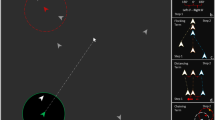Abstract
This paper considers the evolution of cooperative behaviors as the interaction among agents using a genetic algorithm to improve the performance of the task in a group (group performance). Previous research often usedthe group fitness method, which evaluates group performance for the evolution of multiple groups in parallel. However, this entails large simulation costs and the evolution speed is slow.The individual fitness method that evaluates theindividual performance of the task entails a smaller simulation cost. However, it can not improve the group performance since each agent behaves selfishly. To optimize the group performance, it is important to include bothcompetition andsharing. Therefore, this paper presentsthe species fitness method, which shares the individual performances of agents belonging to the same species in a group that all have the same chromosomes. We show comparative experiments on these three methods on the evolutionary simulation of a foraging task in a group. To test the interaction among the agents, four kinds of species are evolved which show their communication ability by demonstrating whether the agent can send or receive the signal for food. Experimental results show that evaluating the species variance fitness leads the agents into reciprocative actions.
Similar content being viewed by others
References
Nowak MA, May RM, Sigmund K (1995) The arithmetics of mutual help. Sci Am June, 76–81.
Saunders GM, Pollack JB (1996) The evolution of communication schemes over continuous channels. In: Maes P et al. (eds) Proceedings of the 4th International Conference on Simulation of Adaptive Behavior (SAB-4). MIT Press, Massachusetts, pp 580–589
Unemi T (1993) Collective behavior of reinforcement learning agents. Proceedings of the 1993 IEEE/Nagoya University WWW on Learning and Adaptive System, Nagoya, pp 92–97
Hamilton WD (1964) The genetical evolution of social behavior I, II, J Theor Biol 7:1–52
Sen S (1996) A foundational principle for promoting cooperative behavior among self-interested agents. In: Tokoro M (ed) Proceedings of the Second International Conference on Multi-Agent Systems (ICMAS-96). AAAI press, California, pp 322–329
Kitahashi M, Yamaguchi T, Yachida M (1998) The species fitness method for the evolution of cooperative behavior in a group task. In: Sugisaka M (ed) Proceedings of the 3th International Symposium on Artificial Life and Robotics (AROB3), Beppu, Oita, Japan. January 19–21, 1998, pp 170–173
Werner GM, Dyer MG (1991) Evolution of communication in artificial organisms. Artificial life II. Addison-Wesley, New York, pp 659–687
Ono N, Rahmani AT (1993) Self-organization of communication in distributed learning classifier systems. In: Albrecht RF et al. (eds) Proceedings of the International Conference on Artificial Neural Networks and Genetic Algorithms, Springer-Verlag, pp 361–367
Author information
Authors and Affiliations
Corresponding author
About this article
Cite this article
Yamaguchi, T., Kitahashi, M. & Yachida, M. The species fitness method for the evolution of cooperative behavior in a group task. Artif Life Robotics 3, 127–132 (1999). https://doi.org/10.1007/BF02481127
Received:
Accepted:
Issue Date:
DOI: https://doi.org/10.1007/BF02481127




